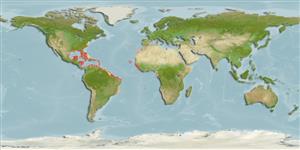>
Acanthuriformes (Surgeonfishes) >
Acanthuridae (Surgeonfishes, tangs, unicornfishes) > Acanthurinae
Etymology: Acanthurus: Greek, akantha = thorn + Greek, oura = tail (Ref. 45335).
More on author: Bloch.
Environment: milieu / climate zone / depth range / distribution range
ນິເວດວິທະຍາ
ສັດທະເລ ກ່ຽວກັນຫີນ; ລະດັບຄວາມເລິກ 2 - 25 m (Ref. 7345), usually 2 - 15 m (Ref. 27115). Subtropical; 22°C - 25°C (Ref. 27115); 43°N - 30°S, 98°W - 14°W (Ref. 55164)
Western Atlantic: Massachusetts (USA), Bermuda, and the northern Gulf of Mexico to São Paulo, Brazil. Eastern Atlantic: Senegal.
Length at first maturity / ຂະໜາດ / ນ້ຳໜັກ / Age
Maturity: Lm ?, range 17 - ? cm
Max length : 39.0 cm TL ຕົວຜູ້/ບໍ່ມີເພດ; (Ref. 47377); common length : 35.0 cm TL ຕົວຜູ້/ບໍ່ມີເພດ; (Ref. 5217); ນ້ຳໜັກສູງສຸດທີ່ເຄຍຈັດພີມມາ: 5.1 kg (Ref. 40637)
ຄີ (ໜາມ)ແຂງຢູ່ຫຼັງປາ (ທັງໝົດ) : 9; ຄີຫຼັງຂອງປາ (ຄີອ່ອນ) (ທັງໝົດ) : 24 - 25; ຄີ(ໜາມ) ແຂງຢູ່ຄີກົ້ນປາ
ກຸ່ມປາກະດູກແຂງ
ຄວາມຖີ່ຂອງກຸ່ມຖ່າຍທອດພັນ
ປາທີ່ມີການເຄື່ອນຍ້າຍຈາກທະເລໄປຫານ້ຳຈືດ ແລະນ້ຳຈືດຫາທະເລ
ປາທີ່ມີການເຄື່ອນຍ້າຍຈາກທະເລແລະໄປໄຂ່ຢູ່ນ້ຳຈືດ
ຄີກົ້ນຂອງປາ
ສັດທີ່ມີກະດູກສັນຫັຼງ
ການຖ່າຍທອດທາງກຳມະພັນຈາກພໍ່ແມ່ຫາລູກ: 3; ຄີກົ້ນຂອງປາ: 22 - 23. Caudal fin slightly emarginate (Ref. 13442). Body gray, with 10 well-spaced, narrow, darker gray vertical bars on side (Ref. 26938).
Inhabits shallow reefs or rocky areas. Found in loose aggregations (Ref. 9710). Mainly diurnal. Ingests sand when feeding on algae (Ref. 13442). The spine on both sides of the caudal peduncle may inflict painful wounds (Ref. 5217). Minimum depth reported from Ref. 27115. Larvae are planktonic (Ref. 47377). At Fernando de Noronha Archipelago in southwestern Atlantic, juveniles hold cleaning stations together with the blue tang (Acanthurus coeruleus) and sergeant major (Abudefduf saxatilis) and graze algae as well as pick molted skin and parasites from green turtles (Chelonia mydas). This behavior is preceded by a characteristic inspection usually followed by feeding nips on the turtles’ skin (head, limbs, and tail), as well as on the carapace. The most inspected and cleaned body parts are the flippers (Ref. 51385).
Life cycle and mating behavior
Maturities | ການສືບພັນ | Spawnings | Egg(s) | Fecundities | ຕົວອ່ອນ
Robins, C.R. and G.C. Ray, 1986. A field guide to Atlantic coast fishes of North America. Houghton Mifflin Company, Boston, U.S.A. 354 p. (Ref. 7251)
IUCN Red List Status (Ref. 130435)
Threat to humans
Traumatogenic (Ref. 5217)
Human uses
ການປະມົງ: ທີ່ເປັນການຄ້າໜ້ອຍ; ຕູ້ປາ: ເປັນສີນຄ້າ
ເຄື່ອງມື
Special reports
Download XML
ແຫຼ່ງອີນເຕີເນັດ
Estimates based on models
Preferred temperature (Ref.
123201): 26.1 - 28, mean 27.4 °C (based on 769 cells).
Phylogenetic diversity index (Ref.
82804): PD
50 = 0.5000 [Uniqueness, from 0.5 = low to 2.0 = high].
Bayesian length-weight: a=0.02188 (0.01789 - 0.02676), b=2.95 (2.91 - 2.99), in cm total length, based on LWR estimates for this species (Ref.
93245).
ຊັ້ນເຂດຮ້ອນ (Ref.
69278): 2.1 ±0.1 se; based on diet studies.
ຄວາມຢືດຢຸ່ນ (Ref.
120179): ຂະໜາດກາງ, ປະຊາກອນຕຳ່ສຸດທີ່ໃຊ້ເວລາສອງເທົ່າ 1.4 - 4.4 ປີ (K=0.25-0.50).
Fishing Vulnerability (Ref.
59153): Low vulnerability (23 of 100).
Nutrients (Ref.
124155): Calcium = 39.8 [15.6, 133.0] mg/100g; Iron = 0.822 [0.286, 2.182] mg/100g; Protein = 19.1 [17.8, 20.4] %; Omega3 = 0.146 [0.063, 0.347] g/100g; Selenium = 8.83 [2.71, 27.87] μg/100g; VitaminA = 17.5 [3.7, 82.5] μg/100g; Zinc = 1.78 [0.55, 3.61] mg/100g (wet weight);
